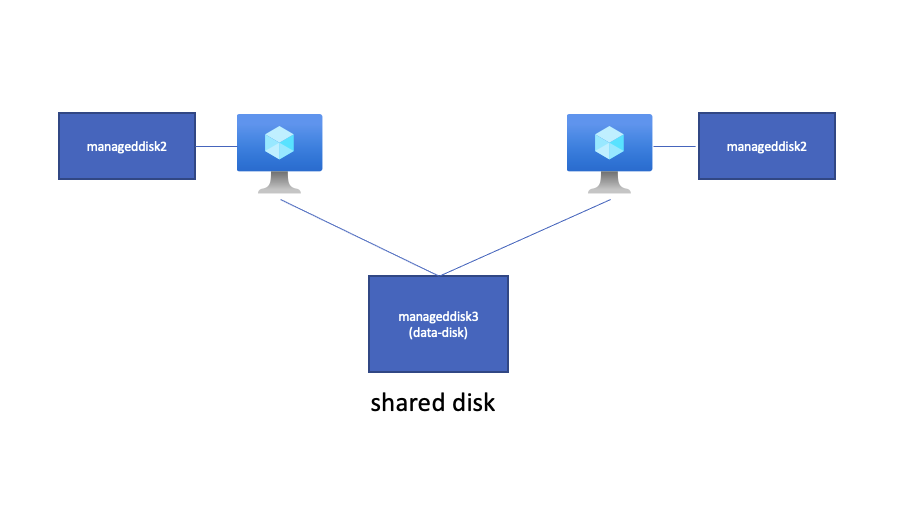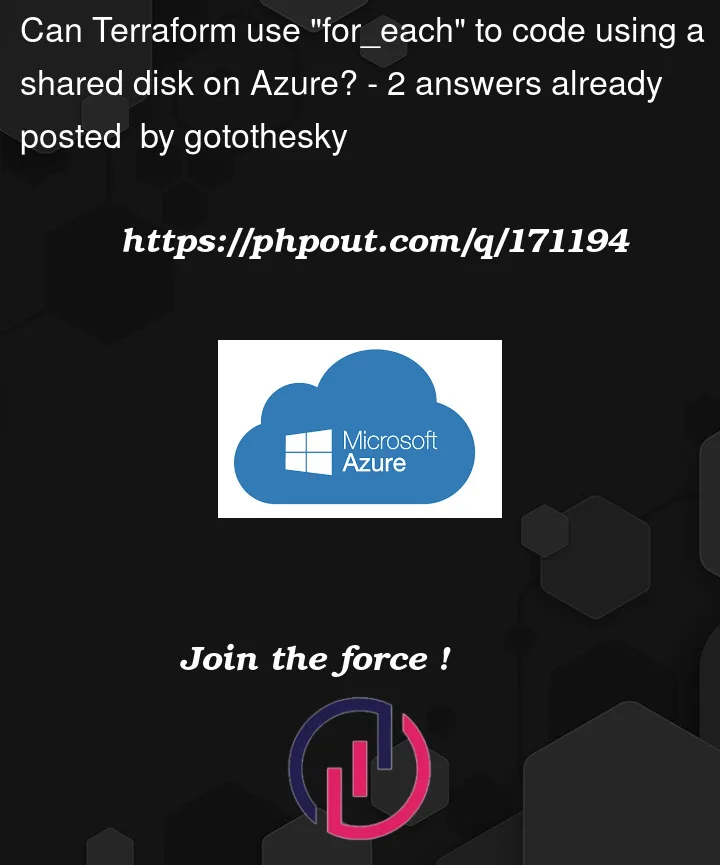
I want to implement it as below.
I want to create "localdisk" as many as the number of VMs, that is, if there are two VMs, I want to create one each.(The code I have now is implemented like this)
For "data-disk", I want to share 1 "data-disk" in 2 VMs and use it.
Currently, my terraform code is as follows.
- managedisk.tf
locals {
disk_vm_flat = merge([
for vm, vm_vals in var.vm_template : {
for disk, disk_vals in var.disk_template :
"${vm_vals.vm_name}-${disk_vals.managed_disk_name}" => {
vm = vm
vm_name = vm_vals.vm_name
managed_disk_name = disk_vals.managed_disk_name
managed_disk_size = disk_vals.managed_disk_size
managed_disk_lun = disk_vals.managed_disk_lun
managed_disk_type = disk_vals.managed_disk_type
managed_disk_caching = disk_vals.managed_disk_caching
os_type = disk_vals.os_type
create_option = disk_vals.create_option
max_shares = disk_vals.max_shares
} if disk_vals.managed_disk_size != "0"
}
]...)
}
resource "azurerm_managed_disk" "managed_disk" {
for_each = local.disk_vm_flat
name = "${each.value.vm_name}-${each.value.managed_disk_name}"
location = var.location
resource_group_name = data.azurerm_resource_group.system_rg_name.name
storage_account_type = each.value.managed_disk_type
create_option = each.value.create_option
max_shares = each.value.max_shares
os_type = each.value.os_type
disk_size_gb = each.value.managed_disk_size
}
resource "azurerm_virtual_machine_data_disk_attachment" "disk_attach" {
for_each = local.disk_vm_flat
managed_disk_id = azurerm_managed_disk.managed_disk[each.key].id
lun = each.value.managed_disk_lun
caching = each.value.managed_disk_caching
virtual_machine_id = azurerm_windows_virtual_machine.vm[each.value.vm].id
}
- var.tf
variable "vm_template" {
type = map(any)
default = {
vm2 = {
vm_name = "test02"
hostname = "test02"
os_publisher = "MicrosoftWindowsServer"
os_offer = "WindowsServer"
os_sku = "2022-datacenter-azure-edition"
license_type = "Windows_Server"
os_version = "latest"
osdisk_type = "StandardSSD_LRS"
osdisk_size = "128"
vm_type = "Standard_D4s_v5"
nic = "nic01"
os_disk = "osdisk01"
}
vm3 = {
vm_name = "test03"
hostname = "test03"
os_publisher = "MicrosoftWindowsServer"
os_offer = "WindowsServer"
os_sku = "2022-datacenter-azure-edition"
license_type = "Windows_Server"
os_version = "latest"
osdisk_type = "StandardSSD_LRS"
osdisk_size = "128"
nic = "nic01"
os_disk = "osdisk01"
}
}
}
variable "disk_template" {
type = map(any)
default = {
disk1 = {
managed_disk_name = "localdisk"
managed_disk_type = "StandardSSD_LRS"
managed_disk_size = "10"
managed_disk_lun = "1"
managed_disk_caching = "ReadWrite"
create_option = "Empty"
os_type = "Windows"
max_shares = "1"
}
disk2 = {
managed_disk_name = "data-disk"
managed_disk_type = "StandardSSD_LRS"
managed_disk_size = "10"
managed_disk_lun = "2"
managed_disk_caching = "ReadWrite"
create_option = "Empty"
os_type = "Windows"
max_shares = "2"
}
}
}
Is there anyone who can help?




2
Answers
I wrote the following code with some hints from your help. Can we make it a little simpler? @Marcin
The problem stems from the fact that you are mixing
localdiskanddata-diskin a single variablevar.disk_template. Altough you could hack up TF code for that, it will be simply overly complex and confusing.Thus, the best way, imo, is to have a separate variable for
data-diskwith the associated separate resource. I assume that you have only one shared drive, as your diagram suggest that. For example (the code probably needs some adjustment to work properly, but it shows the overall idea behind the new design):then
and the attachments: